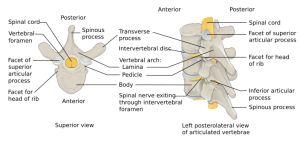Cervical fractures and dislocations: Difference between revisions
ClaireLewis (talk | contribs) |
No edit summary |
||
| (16 intermediate revisions by the same user not shown) | |||
| Line 1: | Line 1: | ||
{{Adult top}} [[cervical injury (peds)]] | |||
== | ==Background== | ||
{{ | [[File:Grant 1962 664.png|thumb|Sensation of cervical nerve roots]] | ||
[[File:Three-column-concept-2.jpg|thumb|Three column concept of spinal fracture stability]] | |||
{{Vertebral fractures and dislocations types}} | |||
== | ==Clinical Features== | ||
* | C-spine injuries may present with | ||
*Rarely [[neurogenic shock]] (bradycardia, hypotension) | |||
*Posterior neck pain | |||
*Pain on palpation of spinous processes | |||
*Limited neck ROM with pain | |||
*Weakness, numbness, or paresthesias | |||
==Differential Diagnosis== | ==Differential Diagnosis== | ||
{{Blunt neck trauma DDX}} | {{Blunt neck trauma DDX}} | ||
{{Neck pain DDX}} | |||
==Evaluation== | |||
[[File:Vertebral lines.png|thumb|Plain films lines]] | |||
*See [[blunt neck trauma]] for general workup | |||
==Management== | ==Management== | ||
| Line 14: | Line 26: | ||
*Hospital | *Hospital | ||
**See page for specific fracture | **See page for specific fracture | ||
**[[Cervical spine clearance]] | |||
==Disposition== | |||
==See Also== | ==See Also== | ||
*[[Blunt neck trauma]] | |||
*[[Cervical spine clearance]] | |||
*[[C-Spine (EAST)]] | *[[C-Spine (EAST)]] | ||
*[[Penetrating neck trauma]] | *[[Penetrating neck trauma]] | ||
| Line 24: | Line 41: | ||
*[[Vertebral fractures]] | *[[Vertebral fractures]] | ||
*[[Cervical injury (peds)]] | *[[Cervical injury (peds)]] | ||
==References== | ==References== | ||
| Line 32: | Line 46: | ||
[[Category:Trauma]] | [[Category:Trauma]] | ||
[[Category:Neurology]] | |||
[[Category:Orthopedics]] | [[Category:Orthopedics]] | ||
Latest revision as of 19:42, 9 October 2024
This page is for adult patients. For pediatric patients, see: cervical injury (peds)
Background
Vertebral fractures and dislocations types
- Cervical fractures and dislocations
- Thoracic and lumbar fractures and dislocations
Clinical Features
C-spine injuries may present with
- Rarely neurogenic shock (bradycardia, hypotension)
- Posterior neck pain
- Pain on palpation of spinous processes
- Limited neck ROM with pain
- Weakness, numbness, or paresthesias
Differential Diagnosis
Neck Trauma
- Penetrating neck trauma
- Blunt neck trauma
- Cervical injury
- Neurogenic shock
- Spinal cord injury
Neck pain
- Musculoskeletal
- Torticollis
- Dystonic reaction
- Cervical spondylosis
- Cervical stenosis
- Cancer
- Epidural abscess
- Vertebral osteomyelitis
- Transverse myelitis
- Temporal arteritis
- Epidural hematoma (anticoagulation, hemophilia)
- Cervical disk herniation
- Blunt neck trauma
- Anterior horn disease
- Cervical fractures and dislocations
- Cervical radiculopathy
Evaluation
- See blunt neck trauma for general workup
Management
- Prehospital
- Hospital
- See page for specific fracture
- Cervical spine clearance
Disposition
See Also
- Blunt neck trauma
- Cervical spine clearance
- C-Spine (EAST)
- Penetrating neck trauma
- Spinal Cord Trauma
- Spinal Cord Compression (Non-Traumatic)
- Neurogenic Shock
- Unstable spine fractures
- Vertebral fractures
- Cervical injury (peds)







